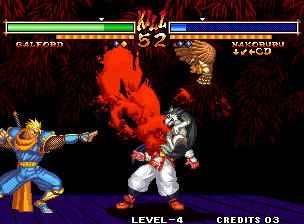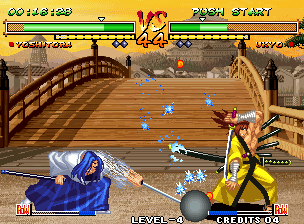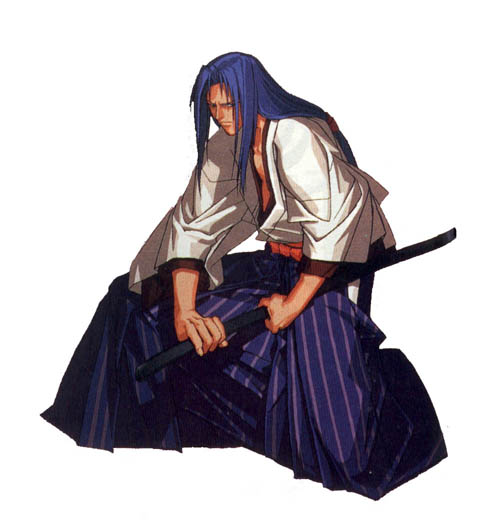

Samurai Shodown V has perhaps the most vibrant graphics seen up to this to point in the 2D titles and boasts a rather large roster of 24 characters. Finally, the character specific fatalities from Samurai Shodown IV have been removed. It’s useful and easily abused, but after playing the game for awhile, it becomes predictable. By activating a command when you’re low on health, your character slows down time Matrix-style and can inflict massive damage on the enemy for a comeback. Also new to the system is the Concentration One system.

Pressing C and D at the same time results in an attack that shoves your opponent and prevents them from blocking. The C button is for kicks, and the D buttons executes several defensive maneuvers, such as rolls, dodges, and quick jumps. The control system has been changed up once again: A is a weak attack, B is a medium attack, and pressing both is a strong attack. To regain strength, the player is required to “meditate” or withhold their attacks. The meter decreases when attacks are used, which in turn makes your strikes weaker.

Also new is the Sword Gauge, which is a means of regulating attack power. The system resembles Samurai Shodown II, with a great emphasis on timing and carefully placed attacks, in contrast to the aggressive, combo based nature of Samurai Shodown III and IV. Samurai Shodown V takes a slower, more deliberate pace than the previous two games. The Xbox version tries to compensate for this with translated ending quotes, but that’s really it. The American version actually skimps on the story entirely – it simply has all cutscenes and endings removed, which is really quite disappointing because the dialogue is interesting. This is the reasoning for its Japanese title, but was changed to Samurai Shodown V for the American release to reflect the game’s placement in the series’ release history, rather than in the plot. This game’s storyline operates in 1786, a whie prior to the first Samurai Shodown. Samurai Shodown V‘s plot involves the coup d’etat of the Japanese government by a demonic general named Gaoh Kyougoku Hinowanokami, who begins a rebellion to save the country. However, it’s far from perfect, and not quite the triumphant return many had hoped it would be. Samurai Shodown V plays somewhat differently than the earlier titles, yet captures their unique feel. While The King of Fighters was handled by Eolith and Metal Slug ended up with Mega Enterprises, this Samurai Shodown title came from Yuki Enterprises (who later went on to create their own 2D fighting game series, Arcana Heart). This was during the period when SNK was in bankruptcy and had to (temporarily) hand over some of their properties to other companies. Dubbed Samurai Spirits Zero (and Samurai Shodown V in the West), it’s meant to be a prequel, and was released to Japanese arcades in 2003. Seven years after Samurai Shodown IV, a new 2D Samurai Shodown title surfaced on the Neo Geo system.


 0 kommentar(er)
0 kommentar(er)
